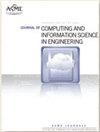工程系统功能分解的形式化定性物理推理
IF 2.6
3区 工程技术
Q2 COMPUTER SCIENCE, INTERDISCIPLINARY APPLICATIONS
Journal of Computing and Information Science in Engineering
Pub Date : 2023-06-16
DOI:10.1115/1.4062748
引用次数: 0
摘要
在早期的系统工程和设计中,功能分解是一项重要的任务,其中系统的整体功能被分解为其组件或子组件的功能。通常,这项任务是手动执行的,因为可能存在多种解决路径,并且需要了解可以实现预期效果的物理现象。为此,本文提出了一种使用基于物理的定性推理进行功能分解的形式化方法。正式表示包括三个部分:(1)可用于检测物质和能量流的物理状态变化的自然语言词汇;(2)一组因果表,通过捕获物理现象或过程中涉及的各种量之间的因果关系,抽象出定性物理知识;(3)将物理过程转化为功能结构结构的过程到子图映射。该算法使用上述三种表示和一些额外的拓扑推理来合成和组装功能结构图,这些图是给定黑箱模型的分解。本文给出了该方法的形式化表示和推理算法,并以空气加热装置的函数模型为例进行了说明。它还介绍了表示和算法的软件实现,并使用它来验证该方法从黑盒函数模型生成多个分解的能力。本文章由计算机程序翻译,如有差异,请以英文原文为准。
Formal Qualitative Physics-Based Reasoning for Functional Decomposition of Engineered Systems
Functional decomposition is an important task in early systems engineering and design, where the overall function of the system is resolved into the functions of its components or subassemblies. Conventionally, this task is performed manually, because of the possibility of multiple solution paths and the need for understanding the physics phenomena that could realize the desired effects. To this end, this paper presents a formal method for functional decomposition using physics-based qualitative reasoning. The formal representation includes three parts: (1) a natural language lexicon that can be used to detect the changes of physical states of material and energy flows, (2) a set of causation tables that abstracts the knowledge of qualitative physics by capturing the causal relations between the various quantities involved in a physical phenomenon or process, and (3) a process-to-subgraph mapping that translate the physical processes to function structure constructs. The algorithms use the above three representations and some additional topological reasoning to synthesize and assemble function structure graphs that are decompositions of a given black box model. The paper presents the formal representations and reasoning algorithms, and illustrates this method using an example function model of an air-heating device. It also presents the software implementation of the representations and the algorithms and uses it to validate the method’s ability to generate multiple decompositions from a black box function model.
求助全文
通过发布文献求助,成功后即可免费获取论文全文。
去求助
来源期刊
CiteScore
6.30
自引率
12.90%
发文量
100
审稿时长
6 months
期刊介绍:
The ASME Journal of Computing and Information Science in Engineering (JCISE) publishes articles related to Algorithms, Computational Methods, Computing Infrastructure, Computer-Interpretable Representations, Human-Computer Interfaces, Information Science, and/or System Architectures that aim to improve some aspect of product and system lifecycle (e.g., design, manufacturing, operation, maintenance, disposal, recycling etc.). Applications considered in JCISE manuscripts should be relevant to the mechanical engineering discipline. Papers can be focused on fundamental research leading to new methods, or adaptation of existing methods for new applications.
Scope: Advanced Computing Infrastructure; Artificial Intelligence; Big Data and Analytics; Collaborative Design; Computer Aided Design; Computer Aided Engineering; Computer Aided Manufacturing; Computational Foundations for Additive Manufacturing; Computational Foundations for Engineering Optimization; Computational Geometry; Computational Metrology; Computational Synthesis; Conceptual Design; Cybermanufacturing; Cyber Physical Security for Factories; Cyber Physical System Design and Operation; Data-Driven Engineering Applications; Engineering Informatics; Geometric Reasoning; GPU Computing for Design and Manufacturing; Human Computer Interfaces/Interactions; Industrial Internet of Things; Knowledge Engineering; Information Management; Inverse Methods for Engineering Applications; Machine Learning for Engineering Applications; Manufacturing Planning; Manufacturing Automation; Model-based Systems Engineering; Multiphysics Modeling and Simulation; Multiscale Modeling and Simulation; Multidisciplinary Optimization; Physics-Based Simulations; Process Modeling for Engineering Applications; Qualification, Verification and Validation of Computational Models; Symbolic Computing for Engineering Applications; Tolerance Modeling; Topology and Shape Optimization; Virtual and Augmented Reality Environments; Virtual Prototyping

 求助内容:
求助内容: 应助结果提醒方式:
应助结果提醒方式:


